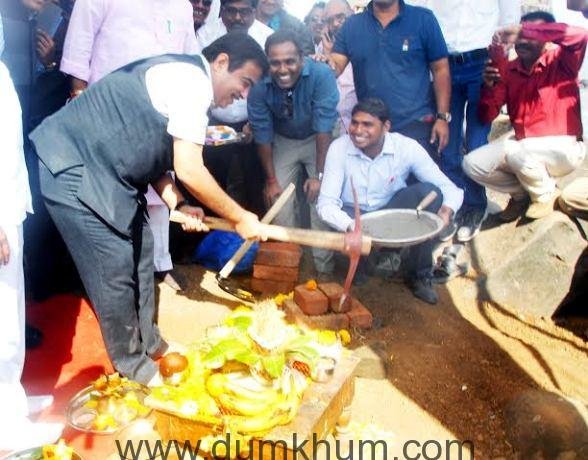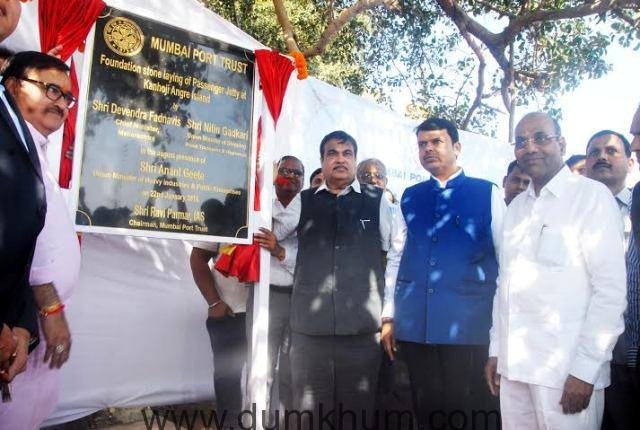Nitin Gadkari lays foundation stone for passenger jetty at Kanhoji Island
Lighthouse tourism to boost tourist footfalls; 2017 to be ‘Visit Maharashtra’ Year
The foundation stone for construction of a passenger jetty at Kanhoji Angre Island off Mumbai coast was laid by the Union Minister for Shipping, Road Transport & Highways, Shri Nitin Gadkari and Chief Minister of Maharashtra, shri Devendra Fadnvis in the presence of Union Minister For Heavy Industries & Public Enterprises Shri Anant Geete. The Island and tourism development work is part of the Ministry of Shipping’s Lighthouse tourism project.
Speaking on the occasion Shri Gadkari said his ministry has drawn up an ambitious plan to develop 78 Lighthouse across the country as tourist destination. Such identified lighthouse are in the state of Maharashtra, Gujarat, Goa, Karnataka, Kerala, Lakshydwip, Tamilnadu, Pondicherry, Aandhra Pradesh, Orissa, West Bengal and Andaman-Nikobar Island. The Minister asserted that while developing lighthouses as tourist destinations, every effort would be made to preserve the history and heritage associated with them.
Shri Gadkari said for several years these lighthouses and Isalands had remaind neglected . He said the Government’s decision to the develop them as tourist attraction would give employment opportunity and new means of livelihood for the locals.
Maharashtra Chief Minister Shri Devendra Fadnvis welcomed the idea of developing lighthouses as tourist attraction and said the state would benefit from it. He said his Government has accorded high priority to tourism and announced that the year 2017 will be declared as ‘VISIT MAHARASHTRA YEAR’.
Mumbai Port Trust has given in principle approval to Maharashtra Tourism Development Corporation for undertaking works related to tourism promotion on the island. The jetty being constructed at a cost of RS. 16 crores will facilitate smooth berthing of passenger boats and embarkation/ disembarkation of the passengers at the island. The jetty will be 37 metres long and 10 metre wide and will be connected to the island by a 150 metre long approach.
The Kanhoji Angre Island lighthouse was built in 1867 by the erstwhile Government of Bombay at an expenditure of Rs 1.22 lakhs. Kanhoji Angre Island, earlier known as Kennery (Khanderi in Marathi) Island is situated in mid sea off the coast of Thal village near Alibag. The island is about 4.5 kms from Thal, 9.5 kms from Alibag and 23 kms from Gateway of India. Kanhoji Angre Light House marks the entry point to the Mumbai harbour and acts as prime aid to navigation of ships entering and leaving Mumbai Ports.
PIB Mum | IJhala (MD)
HRD Ministry appoints Judicial Commission to look into Hyderabad Central University incident
New Delhi | January 22, 2016
Based on its observations and findings, the Ministry of Human Resources Development has decided to constitute a Judicial Commission to review the entire sequence of events and the circumstances; and to establish the facts and correctives in the context of the Hyderabad Central University. The Judicial Commission will submit its report within 3 months.
The Union Minister Smt Smriti Irani today spoke to the mother of Rohith Vemula, the young research scholar who ended his life, and extended her condolences.
In order to address the issues faced by the students from disadvantaged social, economic and educational backgrounds in higher educational institutions comprehensively and to prevent such unfortunate incidents in future, the Ministry has decided on the following course of action:
· A programme will be launched for sensitising academic administrators about understanding and handling problems faced by socially, educationally and economically disadvantaged students. All wardens, administrative staff and Registrars would be compulsorily put through this orientation programme. A special module will be prepared for this orientation.
· A special mechanism would be set up at the Ministry for receiving and taking expeditious action on the grievances from these students.
· All Vice Chancellors and senior administrators would be sensitised to reach out to socially, economically and educationally disadvantaged students. There should be zero tolerance for any acts of discrimination on campus. A special Charter would be issued to all the higher education institutes in this regard.
· The Peer-group Assisted Learning (PAL) of IIT Gandhinagar would be extended to all the higher education institutes, under which Mentors would be arranged for the socially, economically and educationally disadvantaged students not only to assist them in education, but to support them with regards to challenges being faced by them within their Institutions.
PIB Del|GG
Environment Ministry notifies stricter water management standards for sugar industry
New Delhi | January 22, 2016
The Government has notified stricter environment standards for sugar industries operating in various states in the country.
The primary aim of these standards is to minimise water pollution.
Specific wastewater discharge standards have been made stricter, by limiting the same to ‘200 litre per tonne of cane crushed’, as against the earlier limit of ‘400 litre per tonne cane crushed’. This will ultimately result in less consumption of raw water at operational level.
The final treated effluent discharge has been restricted to 100 litre per tonne of cane crushed and waste water from spray pond overflow, or cooling tower blow down to be restricted to 100 litre per tonne of cane crushed.
Only single outlet point from unit has been allowed to encourage operational efficiency and treated effluent recycling practices. Further, only one outlet/ discharge point will be allowed, which will be covered as per the ‘24×7 online monitoring’ protocol.
The number of effluent quality parameters to be monitored for ascertaining compliance have now been increased to six (6) – i.e. pH, Bio-chemical Oxygen Demand (BOD), Chemical Oxygen Demand (COD), Total Suspended Solids (TSS), Total Dissolved Solids (TDS) and Oil & Grease (O&G). Earlier, the notified parameters were only BOD & TSS. The emission limits for particulate matter from stack has been limited to 150milligramme per normal cubic metre.
The waste water conservation and pollution control management mandates that individual units will establish cooling arrangement and polishing tank for recycling excess condensate water
The revised standards have been recommended by the Central Pollution Control Board (CPCB), after consultations with industries and other stakeholders, as well as seeking comments from general public.










